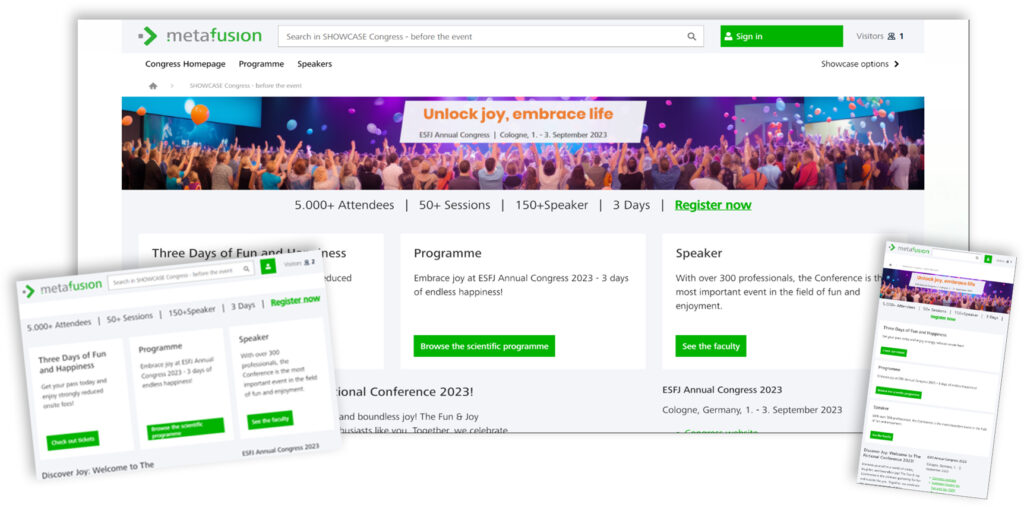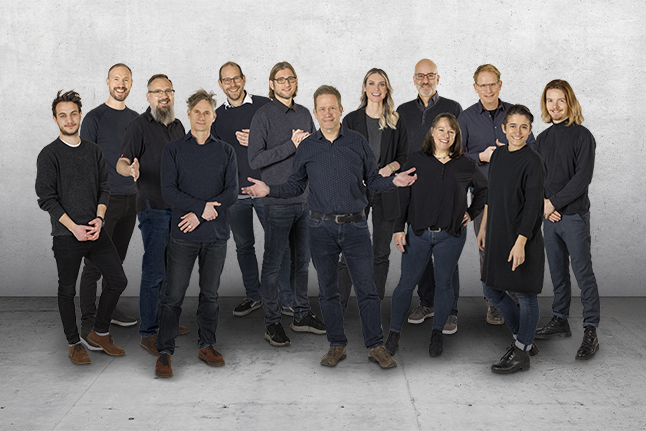Mail info@meta-fusion.com
Phone +49 221 429 135 00
Welcome to our store – come in and have a look around. This is how everyone would like to be welcomed. I look around and discover large signs above the shelves. Great, I quickly skim the signs and find what I’m looking for. It’s the same with an event website – we want clear, concise information on the timetable and speakers. In this blog article, we show you how to achieve this.
In the ever-evolving landscape of the digital era, the importance of well-crafted websites on your platform cannot be overstated. Recognizing this pivotal aspect, the META-DCR platform team has meticulously curated this comprehensive guide to assist you in designing start pages that not only capture the attention of event attendees and organizers but also provide a seamless and enriching user experience. So let’s delve into the key aspects that constitute a compelling and functional homepage, exploring each facet in detail.
The initial impression your event website makes is paramount. That’s why it should promptly address fundamental questions that users might have when landing on your platform. These include understanding the purpose of the platform, the actions users can take, the entities behind the platform, and the accessibility of necessary information.
Visual design plays a crucial role in making a memorable first impression. Employing the ‘F-pattern’ is essential, strategically placing key information where users are likely to notice it first. This pattern is rooted in eye-tracking studies, emphasizing that users tend to prioritize information at the top and left of a webpage, potentially overlooking content on the right.

The hero stage serves as the initial focal point for users, influencing branding and navigation. While visual elements such as images are commonly employed, it’s vital to ensure that textual content remains accessible and SEO-friendly. Critical event facts and information should be presented as text on the page, and internal links are preferred over external ones. It’s noteworthy that despite their apparent appeal, research has indicated that users often overlook content presented in sliders. Thus, it’s advisable to exercise caution in their implementation.
Event websites should be dynamic, adapting to meet the changing needs of users before, during, and after events. Content blocks should possess adaptability, allowing for shifts in prioritization to ensure continued relevance and user motivation. An agile and responsive approach to user needs contributes significantly to the overall success of the platform.
The homepage is a primary navigation tool, often surpassing the significance of the main navigation bar. Ensuring that key features and offerings are easily accessible is paramount, recognizing that users may not consistently rely on the main navigation. An intuitive and user-friendly navigation system enhances the overall user experience, fostering engagement.
The semantic structure of content plays a pivotal role in user comprehension. Headings should accurately reflect the hierarchy of the content, ensuring that even if only the headings are read, users can grasp the essential information. This approach not only improves the user experience, but also positively impacts SEO, contributing to higher visibility on search engines.
All links and buttons on the event homepage should be appropriately labelled, providing clarity to users about the actions they will perform. Reserving buttons for essential links is advisable, maintaining a clean and organized interface. This is particularly crucial when links lead to external pages; users should be well-informed about the destination of their navigation.

Teasers serve a dual purpose by conveying content and guiding navigation. Leveraging captivating images, strategic positioning, and targeted keywords is essential to attract different user groups. Ensuring that key areas are prominently featured within teasers contributes to user engagement and exploration.
A well-structured event webpage with descriptive text, relevant keywords, and a clear hierarchy performs exceptionally well in search engine rankings. Sections of the page should be appropriately labelled with headings, and the text should be crafted creatively to strike a balance between user engagement and search engine optimization. Making content Google-friendly enhances the discoverability of your platform.

Given the proliferation of diverse devices, optimizing your content for accessibility and functionality on various screen sizes is imperative. Conducting thorough usability tests on large screens, smartphones, and tablets ensures a seamless user experience across the spectrum of devices. A responsive design approach reflects a commitment to inclusivity and user satisfaction.
Incorporating engaging multimedia elements such as videos, interactive graphics, and virtual tours can significantly enhance the user experience. Multimedia content provides a dynamic and immersive way to convey information about your events, speakers, and venue. Ensure that multimedia elements are optimized for quick loading times to prevent user frustration and enhance overall page performance.

Integrating social media seamlessly into your event website allows users to connect with your events on various platforms. Display live feeds, event highlights, and user-generated content to foster community engagement. Social media integration not only expands your event’s reach but also provides a real-time and interactive dimension to your platform.
In the era of increasing digital concerns, prioritizing data security is paramount. Assure your users that their information is handled securely by implementing robust data encryption and privacy measures. Clearly communicate your data protection policies and compliance with relevant regulations, instilling confidence in users to interact and engage with your platform.
Implementing personalization features on your homepage can significantly enhance user satisfaction. Analyse user behaviour and preferences to deliver tailored content, recommendations, and event suggestions. Personalization fosters a sense of individualized experience, increasing the likelihood of user engagement and prolonged interaction with your platform.
By meticulously adhering to these extended guidelines, your event website on the META-DCR platform will not only be optimized for functionality and attractiveness, but will also contribute significantly to the success of your events. This holistic approach ensures the satisfaction of both your delegates and organizers, fostering a positive and enduring impression of your platform within the competitive landscape of event management. As the digital realm continues to evolve, an adaptable and user-centric homepage remains a cornerstone in achieving sustained success in the dynamic landscape of event organization.
The homepage of your event website is your front door, where you warmly welcome your visitors and should offer them the best possible service. Often, this is where the starting signal for a successful event is given if the first impression is right and expectations are met. Therefore, you should pay special attention to the design, content, and user-friendliness of your event website.

meta-fusion GmbH is a leading provider of digital congress solutions, with 25 years of experience in producing webcast transmissions of conferences worldwide. We offer comprehensive hybrid meeting solutions and a digital congress platform “Digital Congress Resources” which provide real added value for events and long-term usage of knowledge content.
Our main customers are scientific associations and congress agencies with whom we create future-proof business strategies in the field of scientific education and medicine. We prioritise customer orientation, flexibility and maintain long-term relationships. Our production teams are highly valued for their reliability and pragmatism.
We are based in Cologne, a family-friendly company with a dynamic working environment and potential for employee development.